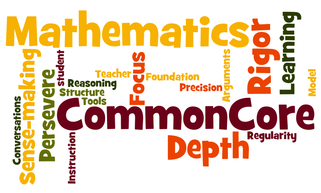Common Core Mathematics

This is in response to Mercedes Deutsch’s call for input from teachers on our experience with Common Core Mathematics
The Standards: Is it really thinner?
Going from California to the CCSS-M standards does have “less”. They’ve taken out a lot from integers. Students don’t have to do any operations, they just work on concepts and value like comparisons, etc. They still have to do the same amount of work in fractions (addition, subtraction, multiplication and division). The problem is that the lack of operations in integers really hinders having them do things like resolving simple algebra equations. For example, to solve 4x + 4 = 12, you need to subtract four from both sides of the equation, something more easily understood when you know how to add/subtract integers. It also means that you can’t really do problems with integers like 4x + (-4) = 12. Since integers are pretty integral to pre-algebra, and early algebra it hampers that development. Others have decried the “rolling-back” of algebra for all, and I don’t know if I want to join that bandwagon since I never thought much about exposing all eighth graders to algebra. Now to the next part. Having kids doing all operations in fractions is problematic, and will continue to be an issue. I hear folks say no worries, they will be getting more fractions earlier so they’ll be ready by the time they get up to you. Yeah, that was how the early algebra curriculum was supposed to work, and I’m not impressed with how that turned out (lots of kids taking algebra two and three times to pass).
Next, what does this mean?
6.RP.3.c
3. Use ratio and rate reasoning to solve real-world and mathematical problems, e.g., by reasoning about tables of equivalent ratios, tape diagrams, double number line diagrams, or equations.
